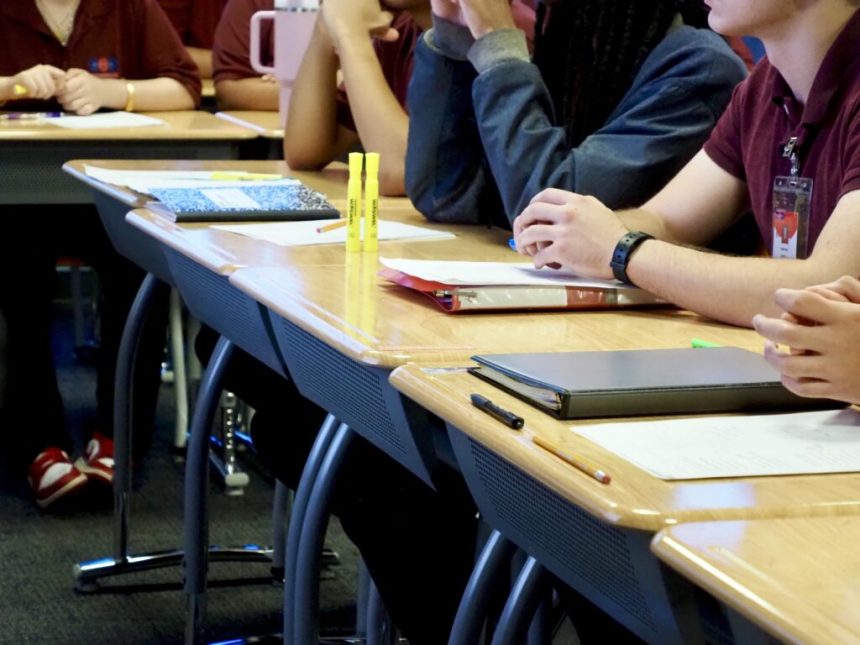Students sit at desks in an English language arts classroom at Dove Science Academy in Warr Acres on Aug. 19. Results of reading and math tests show a significant statewide swing as a result of more rigorous scoring. (Photo by Nuria Martinez-Keel/Oklahoma Voice)
OKLAHOMA CITY — Statewide test scores for reading and math have dropped significantly in Oklahoma public schools since the state returned to more rigorous scoring, according to results the state Department of Education released publicly on Monday.
In the 2024-25 school year, only 27% of third graders were classified as proficient or advanced in reading while 51% were the year before. A similar difference is evident in math testing results, with 33% of Oklahoma third graders hitting grade-level targets, despite 38% doing so in 2023-24.
State officials have warned the lower scores are not the result of worse academic performance, but rather a reflection of more rigorous expectations.
“This year’s test results don’t mean that Oklahoma students are doing worse,” said Megan Oftedal, executive director of the state’s Office of Educational Quality and Accountability. “Our students are learning and working just as hard as before, but the bar for what’s considered ‘Proficient’ has been raised.”
Office of Educational Quality and Accountability executive director Megan Oftedal attends a news conference Thursday at Eisenhower International School in Tulsa where she is announced to be part of a “turnaround team” coming to the Oklahoma State Department of Education. (Photo by Nuria Martinez-Keel/Oklahoma Voice)
Oftedal will soon join the state Education Department as a member of a “turnaround team” advising newly appointed state Superintendent Lindel Fields.
The state lowered expectations in 2024 for how much knowledge students had to demonstrate on state reading and math tests to receive a score of “proficient,” which is defined as showing mastery of grade-level subject matter and readiness for the next grade.
Those who fall below “proficient” are labeled either “basic,” which indicates a student has only partial mastery of concepts at his or her grade level, and “below basic,” which indicates a student has fallen even more significantly behind. Students who perform above a proficient level are considered “advanced.”
The state Education Department developed the lower scoring expectations with committees of Oklahoma teachers and then earned approval in July 2024 from the Commission for Educational Quality and Accountability, which oversees Oftedal’s agency.
The Education Department, under state Superintendent Ryan Walters at the time, then released the 2024 test scores without announcing that a major change in scoring had taken place, leaving districts and families with the false impression that their students had made dramatic leaps in academic progress.
After news media, including Oklahoma Voice, uncovered the scoring change, the commission reversed its 2024 decision, opting to restore the stricter, nationally aligned scoring methods that Oklahoma used from 2017-2023.
That means students needed to have a stronger performance in reading and math this year to be considered proficient. Statewide reading and math tests are administered each spring to grades 3-8.
With more rigorous expectations in place, the 2025 results give the appearance of a major dip in performance, just like the 2024 scores gave an artificial indication of growth.
Reading scores showed the most dramatic swing this year.
Along with the 27% of third graders who scored proficient or higher, only 24% of fourth graders, and 26% of fifth graders did so in reading, according to results the Education Department posted publicly on its website. A quarter of sixth graders, 22% of seventh graders and 21% of eighth graders made a proficient or advanced reading score.
Under last year’s scoring, no grade level had a reading proficiency rate below 39%.
Math results in 2025 classified 33% of third and fourth graders and 27% of fifth graders as scoring at grade level or higher. Only 24% of sixth graders, 25% of seventh graders and 17% of eighth graders in Oklahoma scored proficient or advanced in math.
That’s an across-the-board decline from 2024 math scores. However, 2024 data should be considered an “outlier,” according to guidance from the Office of Educational Quality and Accountability.
The agency advised that the 2025 results are more comparable to 2023, when 26% of all Oklahoma students scored proficient or above in reading and math.
Having higher testing expectations better identifies whether students are on track to be ready for college or a career by the time they graduate high school, Oftedal said. It also more closely aligns with scoring used in national testing.
“Scores may look lower, but what they show is more meaningful,” she said. “Raising expectations helps everyone — parents, teachers, and schools — see more clearly where students are thriving and where they may need extra support. Our students haven’t fallen behind; we’ve simply raised the bar to match their potential and prepare them for the future.”
SUBSCRIBE: GET THE MORNING HEADLINES DELIVERED TO YOUR INBOX









